Embroidery, a timeless craft celebrated for its intricate designs and attention to detail, provides a creative outlet for many.
However, the delicate artistry of embroidery is not without its physical demands. A question frequently posed by enthusiasts is, “Does embroidery hurt your hands?”
The seemingly serene act of stitching involves repetitive motions, fine motor skills, and sustained hand engagement, potentially leading to discomfort.
This inquiry delves into the various factors contributing to hand pain in embroidery, exploring the nuanced interplay between technique, tension, and the unique demands placed on the hands during the creation of embroidered masterpieces.
Understanding these dynamics is essential for fostering a balance between creative expression and physical well-being in the world of needlework.
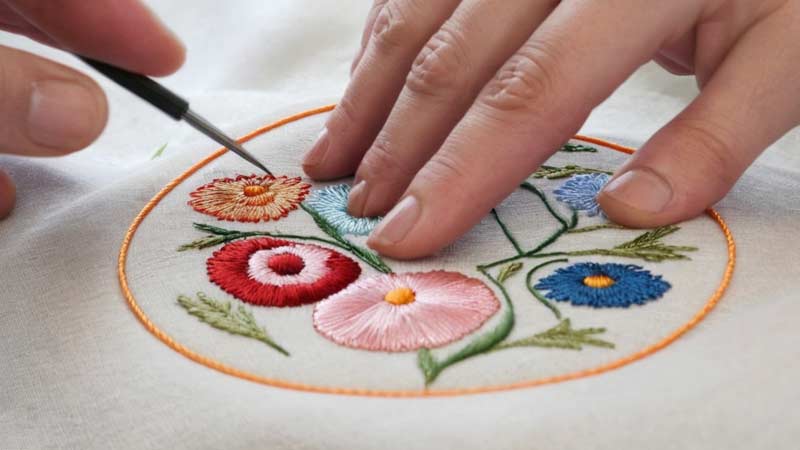
Does Embroidery Hurt Your Hands?
Yes, embroidery can indeed pose risks to your hands and overall physical well-being. The repetitive nature of stitching can lead to strain on the joints in your hands, potentially causing discomfort and, in severe cases, damage.
Prolonged and intense embroidery sessions may contribute to the unhealthy shortening of muscles in the fingers, hands, and arms, leading to stiffness and reduced flexibility.
The constant gripping of needles and manipulation of fabrics can result in cumulative stress, affecting the hands and extending to the entire body. Over time, this can lead to chronic pain and discomfort, negatively impacting one’s quality of life.
It is crucial for individuals engaged in embroidery to be mindful of their hand health, incorporating regular breaks, stretching exercises, and ergonomic practices to mitigate the risk of injury and ensure a sustainable and enjoyable stitching experience.
Reasons Why Does Embroidery Hurt Your Hands?
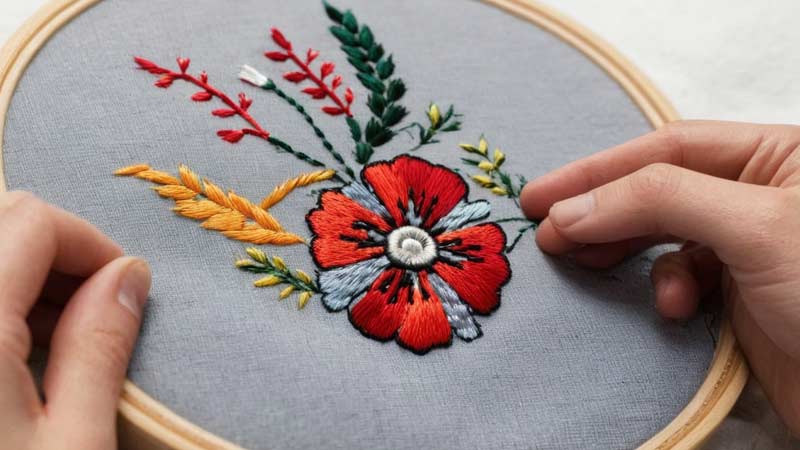
Embroidery, a delicate and intricate form of needlework, is a craft that has been practiced for centuries.
While it brings joy and satisfaction to many enthusiasts, it is common for individuals to experience discomfort or pain in their hands during or after embroidery sessions.
Here are the reasons why embroidery hurts your hands:
Repetitive Motion
The repetitive nature of embroidery, while integral to the craft, can take a toll on the hands over time.
The consistent pushing and pulling of the needle through the fabric and thread manipulation leads to continuous stress on the muscles and joints.
This repetitive motion without adequate breaks can result in muscle fatigue, inflammation, and discomfort.
The strain accumulates gradually, making it imperative for embroiderers to be mindful of their hand movements and take regular breaks to prevent overuse injuries.
Gripping the Needle
Holding a small, thin needle for extended periods demands a certain degree of skill and strength from the hands.
A tight grip on the needle, whether due to the intricacy of the design or personal habit, can exacerbate hand fatigue.
The pressure exerted while gripping may lead to tension in the hand muscles and contribute to discomfort.
Exploring ergonomic needle grips and occasionally changing hand positions can alleviate stress on specific muscles and joints, reducing the likelihood of prolonged discomfort.
Fine Motor Skills
Embroidery’s emphasis on fine motor skills adds a layer of complexity to the hand’s involvement in this craft.
The intricate details and delicate maneuvers required for precise stitching can strain the small muscles in the hands.
Novice embroiderers, in particular, may find that their hands need time to adapt to the level of precision demanded by the craft.
Regular practice, hand exercises, and gradual progression to more intricate designs can help build muscle strength and coordination, minimizing hand strain.
Tension in Thread
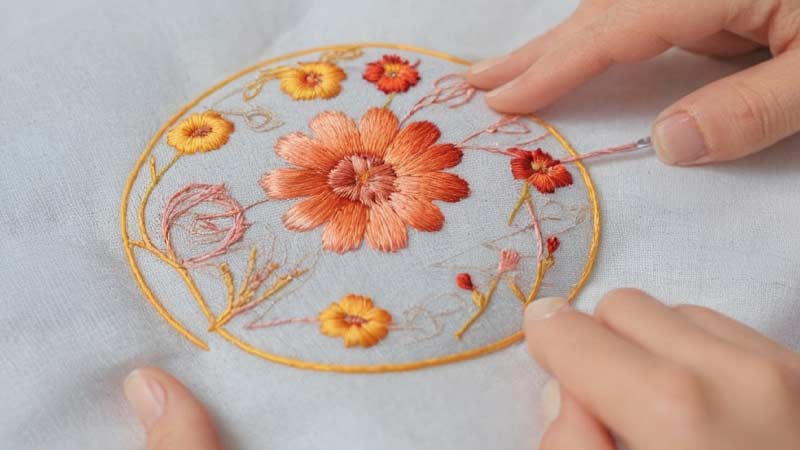
Maintaining the appropriate tension in the embroidery thread is crucial for achieving aesthetically pleasing results.
However, the constant adjustments required to achieve the desired tension can stress the hands.
Regularly pulling and manipulating the thread can strain the muscles and joints, leading to discomfort over time.
Employing tools like embroidery hoops to stabilize the fabric and thread can reduce the need for excessive manual adjustments, alleviating tension-related hand issues.
Improper Technique
Embroidery, when approached with improper techniques, can exacerbate hand pain. Holding the fabric too tightly or forcing the needle through the material can cause unnecessary strain on the hands.
Proper training and guidance on correct embroidery techniques, including the appropriate grip and posture, are crucial for preventing hand discomfort.
Awareness of hand positioning and a conscious effort to maintain a relaxed grip can go a long way in minimizing strain during embroidery.
Extended Sessions
Embarking on extended embroidery sessions without adequate breaks can lead to overuse injuries.
The continuous engagement of the hands in intricate stitching, combined with the repetitive nature of the craft, increases the risk of muscle fatigue and strain.
Embroiderers need to schedule regular breaks, stretch their hands and fingers, and vary their hand movements to prevent overexertion.
Incorporating simple hand exercises during breaks can help maintain flexibility and reduce the likelihood of prolonged discomfort.
Pre-existing Conditions
Individuals with pre-existing hand conditions, such as arthritis or carpal tunnel syndrome, may find embroidery exacerbating their symptoms.
The repetitive movements and fine motor skills required in embroidery can increase pain and discomfort in those with existing hand issues.
It is advisable for individuals with such conditions to approach embroidery with caution, considering ergonomic tools and adapting techniques, and consulting healthcare professionals for personalized advice on how to engage in the craft without compromising their hand health.
How to Avoid Hand Injuries While Embroidery?
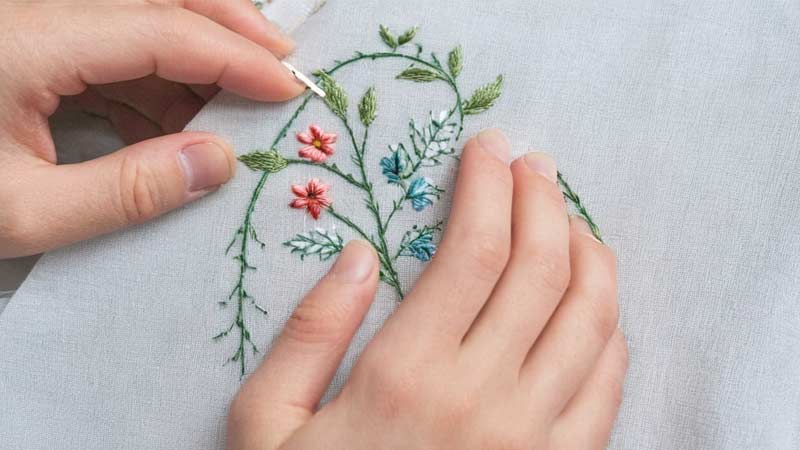
Embroidery, while a delightful and creative pastime, can sometimes lead to hand injuries if proper precautions are not taken.
Here’s a guide on how to avoid hand injuries while embroidering:
Maintain Proper Posture
Sitting in an ergonomic position is crucial for preventing hand injuries during embroidery. Ensure your chair provides proper lumbar support, keeping your back straight and shoulders relaxed.
Position your elbows close to your body to minimize strain on your hands, wrists, and shoulders.
Investing in a comfortable chair with good back support can contribute significantly to maintaining a healthy posture, reducing the risk of musculoskeletal issues associated with prolonged embroidery sessions.
Use an Embroidery Hoop
Using an embroidery hoop is a practical strategy to minimize hand strain. This tool keeps the fabric taut, reducing the need for excessive hand strength during stitching.
A well-tensioned hoop provides a stable surface for embroidery, preventing the fabric from slipping and eliminating the need for a tight grip.
This simple accessory is a valuable ally in preventing overexertion and ultimately lowering the risk of hand injuries.
Choose the Right Tools
Selecting appropriate needles and embroidery floss is fundamental in preventing discomfort and strain. Opt for needles that match the fabric and thread thickness, ensuring they are neither too small nor too large for the task.
Choosing tools with a comfortable grip is equally essential; ergonomic designs can significantly reduce the stress on your hands, promoting a more enjoyable and injury-free embroidery experience.
Take Breaks and Stretch
Embroidering for extended periods can lead to hand fatigue and potential injuries. Integrate regular breaks into your stitching sessions, allowing your hands to rest and recover.
During breaks, incorporate simple stretching exercises for your fingers, hands, and wrists. Stretching helps maintain flexibility, reduces muscle tension, and minimizes the risk of repetitive strain injuries associated with prolonged embroidery work.
Warm-Up Exercises
Before delving into a lengthy embroidery session, incorporate warm-up exercises to prepare your hands for the intricate work ahead.
Rotate your wrists in both directions, flex and extend your fingers, and gently massage your palms.
These simple warm-up routines enhance blood circulation, promote joint flexibility, and serve as a proactive measure against potential hand strain during embroidery.
Vary Your Stitching Techniques
Diversifying your stitching techniques is an effective strategy to distribute the workload across different muscles and joints. Rotate between different stitches and hand movements to prevent overuse of specific muscles.
This variety reduces the risk of strain and adds creative flair to your embroidery projects, making the process both enjoyable and health-conscious.
Use Proper Lighting
Well-lit workspaces are essential for preventing eye strain, indirectly reducing hand fatigue. Adequate lighting allows you to see your embroidery clearly, reducing the need to strain your eyes and, consequently, your hands.
Position your work area near a natural light source or invest in quality artificial lighting to create a comfortable and well-illuminated environment.
Stay Hydrated
Dehydration can contribute to muscle cramps and stiffness, impacting the flexibility and comfort of your hands during embroidery.
Drink sufficient water to stay hydrated, especially during longer stitching sessions. Proper hydration supports overall hand health and helps prevent conditions related to muscle tightness and discomfort.
Invest in Ergonomic Tools
Consider upgrading to ergonomic tools specifically designed for embroidery. Ergonomic scissors, needles, and thimbles are crafted to reduce stress on your hands and wrists.
These tools promote a more natural hand position and grip, minimizing the strain associated with traditional embroidery tools. Investing in ergonomic solutions is an investment in the longevity of your hand health.
Listen to Your Body
Pay close attention to any signals of discomfort, pain, or numbness in your hands. If you experience persistent pain, take a break immediately and consider consulting a healthcare professional.
Ignoring discomfort can lead to more severe injuries over time. Prioritize self-care and proactive measures to address signs of strain or discomfort before they escalate into more significant issues.
Ice and Rest
In the event of soreness or swelling, apply ice to the affected area and allow your hands to rest. Avoid pushing through pain, as this can exacerbate the issue.
Rest is crucial for preventing further injury and allowing your hands to recover.
Incorporate short breaks, ice applications, and sufficient rest into your routine to ensure the long-term health of your hands during embroidery endeavors.
How to Embroider by Hand? Step-By-Step Guide
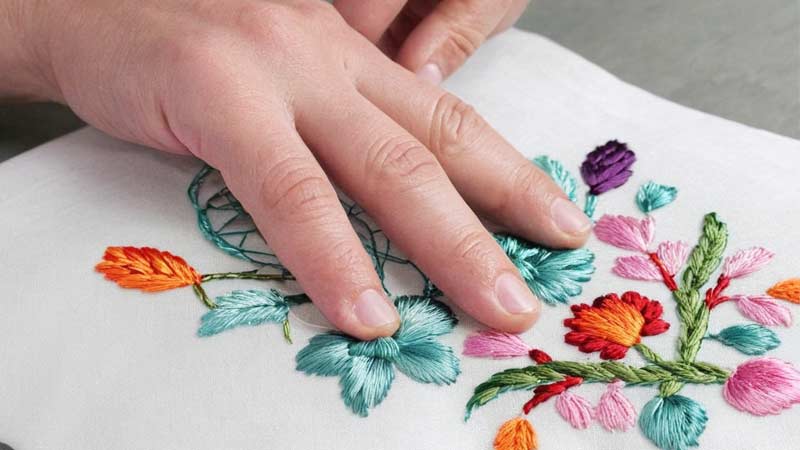
Embroidering by hand is a gratifying and creative craft that allows you to personalize fabrics with intricate designs.
Here’s a step-by-step guide on how to embroider by hand:
1. Gather Supplies
Embarking on a successful hand embroidery project begins with gathering the essential supplies. Collect a variety of embroidery floss in colors that complement your envisioned design.
Ensure you have a selection of embroidery needles, varying in size to suit different fabrics and thread thicknesses.
An embroidery hoop is invaluable for maintaining fabric tension, facilitating smoother stitching. Choose a fabric that aligns with your design goals and opt for a pattern if you seek guidance or inspiration.
2. Choose the Right Needle and Thread
Delve into the world of needle and thread selection, tailoring your choices to match the intricacies of your project.
Opt for larger needles when working with thicker threads, while delicate fabrics benefit from finer needles.
Experiment by separating embroidery floss strands to achieve different thicknesses, keeping in mind that standard floss typically consists of six strands.
This customization ensures that your needle and thread choices harmonize with the demands of your design.
3. Prepare the Fabric
Securing your fabric in an embroidery hoop is a pivotal step in hand embroidery.
Tighten the hoop enough to maintain even tension across the fabric, but avoid excessive stretching. This preparation lays the foundation for precise and neat stitching.
If you follow a pattern, transfer it to the fabric using a water-soluble fabric marker or tracing the design onto the material. This step ensures that your stitching aligns with your envisioned pattern.
4. Start with a Knot
Thread your chosen needle with an appropriate length of embroidery floss and secure it to the fabric with a knot. This initial knot anchors the thread, preventing it from slipping during stitching.
Decide whether to start your embroidery on the front or back of the fabric based on your design preferences. This step sets the stage for the journey ahead.
5. Learn Basic Stitches
Mastering basic embroidery stitches is fundamental to creating beautiful and intricate designs.
Practice the back stitch for outlining, the running stitch for borders or quilting, the French knot for adding texture, the satin stitch for smooth coverage, and the chain stitch for decorative versatility.
A spare piece of fabric becomes your canvas for honing these stitches, enhancing your proficiency and confidence.
6. Follow the Pattern
If you’ve chosen to work from a pattern, diligently follow the designated stitches and color schemes. The pattern serves as a roadmap for your creative journey, providing structure and guidance.
For those venturing into freehand embroidery, this is the stage to unleash your creativity. Experiment with stitch combinations, color variations, and innovative designs to bring your vision to life.
7. Maintain Consistent Tension
Achieving consistent tension in your stitches is pivotal for a polished and professional finish. Strive to maintain an equilibrium where stitches are neither loose nor tight. This attention to detail elevates the overall appearance of your embroidery, ensuring a cohesive and visually appealing result.
8. Secure Ends
Secure the ends of the embroidery floss when transitioning between sections or changing thread colors.
Weave them through existing stitches on the back of the fabric, creating a tidy finish that prevents unraveling. This meticulous step contributes to your embroidered piece’s overall neatness and durability.
9. Personalize and Experiment
Embrace the artistic freedom that hand embroidery offers. Play with an array of colors, experiment with diverse stitches, and explore various textures to create unique and distinctive designs.
As you gain confidence, consider delving into more advanced techniques and styles, allowing your creativity to flourish with each stitch.
10. Finish and Display
As you near completion, remove the fabric from the embroidery hoop. Press the embroidered piece to eliminate any wrinkles, ensuring a pristine finish.
Trim excess fabric to frame or incorporate your creation into more extensive projects such as pillows, bags, or garments. Display your handiwork proudly, showcasing the fruits of your labor and creativity.
Benefits of Hand Embroidery
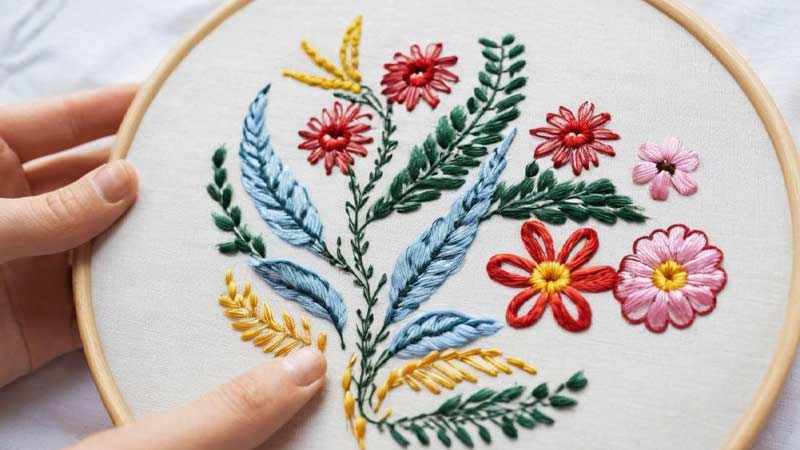
Hand embroidery, a traditional craft with a rich history, offers many benefits beyond creating aesthetically pleasing designs.
Here are several advantages to engaging in hand embroidery:
Therapeutic and Relaxing
Embroidery stands as a therapeutic haven, offering solace to those seeking a respite from the demands of modern life.
The rhythmic motion of the needle through the fabric and the intricate focus demanded by various stitch patterns create a meditative experience.
This repetitive yet mindful process induces a sense of calm, reduces stress, and promotes a serene mental state.
Many enthusiasts find that stitching becomes a form of self-care, allowing them to unwind and escape the pressures of the day.
Enhances Creativity
Hand embroidery is a canvas for boundless creativity, inviting artisans to explore a world of colors, stitches, and patterns.
This craft encourages experimentation, empowering individuals to express their unique artistic visions.
Whether experimenting with different thread textures, combining colors imaginatively, or inventing new stitch patterns, embroidery fosters a sense of creative accomplishment.
This freedom to play and innovate creates a fulfilling and personally expressive crafting experience.
Portable and Accessible
A standout feature of hand embroidery is its portability and accessibility. With a compact set of supplies, needles, thread, and a small hoop, enthusiasts can embark on their creative journey virtually anywhere.
Whether in a tranquil garden, during a commute, or in the coziness of one’s home, the accessibility of embroidery makes it a versatile hobby.
This portability allows for creative expression on the go and makes it an inclusive pastime that accommodates various lifestyles.
Cognitive Benefits
Embarking on an embroidery project is visually rewarding and cognitively stimulating.
The meticulous process of following a pattern and executing precise stitches demands concentration and attention to detail.
This engagement enhances cognitive skills, fostering improved focus and problem-solving abilities.
Embroidery’s rhythmic and repetitive nature provides a unique form of mental exercise, promoting mental understanding and contributing to overall cognitive well-being.
Connects to Tradition
Hand embroidery is a living link to cultural traditions and heritage. Individuals become custodians of historical practices by participating in this age-old craft, preserving skills passed down through generations.
Creating with one’s hands connects the artisan to a rich tapestry of cultural heritage, fostering a deep appreciation for the art form’s timeless significance.
Beyond personal creativity, embroidery becomes a bridge to past traditions, creating a sense of continuity and shared legacy.
Personalized Gifts and Keepsakes
Hand-embroidered items transcend mere craft; they become tokens of affection and thoughtfulness. Creating unique pieces for loved ones allows crafters to imbue their creations with personal meaning.
Whether a monogram on a handkerchief or a custom-designed piece of art, hand embroidery transforms into a heartfelt expression of love and connection.
Crafting a personalized gift fosters a sense of joy in both the creator and the recipient, deepening emotional bonds and creating lasting memories through handmade craftsmanship.
Promotes Patience and Perseverance
Embroidery is a patient art form with intricate stitches and meticulous details. Crafting a complete piece requires dedication, a quality that extends beyond the crafting realm.
The incremental progress, stitch by stitch, teaches the value of patience and perseverance. These virtues become integral aspects of the embroiderer’s journey, instilling a resilient mindset that can be applied to various aspects of life.
As the saying goes, every stitch is a testament to the rewards of sustained effort and meticulous dedication.
Stress Relief
Embarking on a creative pursuit like hand embroidery provides a unique avenue for stress relief. The focused attention required for stitching diverts the mind from daily pressures, offering a welcome escape.
Engaging in a mindful and absorbing task has been shown to reduce stress levels and promote a sense of well-being.
The rhythmic nature of embroidery, combined with the tangible progress achieved with each stitch, creates a therapeutic space where individuals can unwind, relax, and find solace amidst life’s challenges.
Sustainable Crafting
Hand embroidery aligns with sustainable practices, making it an appealing choice for those seeking environmentally-conscious hobbies.
The craft often involves repurposing fabrics, utilizing leftover threads, and minimizing waste.
The eco-friendly nature of hand embroidery resonates with individuals looking to reduce their environmental impact, providing a fulfilling and responsible outlet for creative expression.
By embracing sustainable crafting, enthusiasts contribute to a more mindful and eco-conscious approach to their artistic endeavors.
Community Building
The world of hand embroidery extends beyond solitary crafting, offering opportunities for social interaction and community building.
Joining embroidery circles, attending workshops, or participating in online communities connects enthusiasts with like-minded individuals.
The exchange of ideas, tips, and encouragement fosters a sense of camaraderie among embroidery enthusiasts.
This shared creativity enhances the crafting experience and creates a supportive network where individuals can inspire and learn from one another, forging lasting connections through their shared love for the art of embroidery.
FAQs
Why is hand embroidery considered necessary?
The importance of hand embroidery is valued for its artistic expression, personalization, and connection to cultural traditions.
What role does hand embroidery play in the modern crafting landscape?
In the modern crafting landscape, hand embroidery continues to be cherished for its ability to blend tradition with contemporary creativity.
To Recap
While embroidery is a cherished and rewarding craft, it is not exempt from potential challenges, including hand discomfort.
The repetitive motions, needle gripping, and intricate details demand mindfulness to prevent strain.
By adopting proper techniques, maintaining ergonomic practices, and being attentive to one’s bodies, enthusiasts can minimize the risk of hand discomfort.
Despite the physical demands, the therapeutic benefits, creative fulfillment, and connection to tradition make embroidery gratifying.
Balancing the joy of crafting with proactive measures ensures that embroidery remains a source of delight, contributing to artistic expression and overall well-being.
Leave a Reply